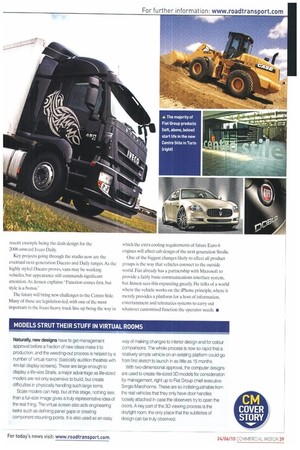The Italian job
Page 54

Page 55

If you've noticed an error in this article please click here to report it so we can fix it.
With Fiat Group products now being developed in a new styling centre, the Italian brand has upped its style game.
Words: Colin Barnett If your Fiat Punto van begins to remind you of a New Holland tractor, or your lveco Stralis tractor carries a few styling cues from a Maserati sports car, it may be because the styling for almost all Fiat Group products is carried out at a combined styling centre, the notable exception being Ferrari.
The new 20,600m Centro Stile is based in one building of many that comprised Fiat's giant Mirafiori car plant in Turin.The former suspension and transmission assembly hall has been gutted and cleaned up, but retains its classic industrial features, including the glazed roof. The result is a bright and spacious working environment, with plenty of natural light.
Although housed in the same building, known internally as Officine 83, with areas such as colour and trim shared across the group, the basic styling function is split into product teams. All of the vocational products come under the command of vice-president of Peter Janse, Fiat professional and industrial vehicle styling, who reports to Lorenzo Ramaciotti, head of style.
The creative element of the 250-strong workforce is primarily in three groups: designers, and computer modellers and physical modellers. The design process begins as it always did, with a sketch on a blank white sheet. The difference is that that white sheet is on a computer screen, making the inevitable changes easier and faster, The key target of the design process is to combine efficiency and speed with the traditional emotion of the Italian styling ethos.
Styling process One implication of the in-house styling process is that less use will be made of external design studios, previously frequently employed on a large scale. They will still be used, but only on a relatively low-key basis on specific projects. Ironically, on the day CM visited Centro Stile, news was breaking, and was subsequently confirmed, that rival Volkswagen was about to acquire control of Giorgietto Giugaro's Hal Design business. hal Design has carried out much work on Fiat brands over the years. one recent example being the dash design for the 2006-onward lveco Daily.
Key projects going through the studio now are the eventual next-generation Ducat° and Daily ranges. As the highly styled Ducato proves, vans may be working vehicles, but appearance still commands significant attention. As Jansen explains: "Function comes first, but style is a bonus.
The future will bring new challenges to the Centro Stile. Many of these are legislation-led, with one of the most important in the Iveco heavy truck line-up being the way in which the extra cooling requirements of future Euro-6 engines will affect cab design of the next generation Stralis.
One of the biggest changes likely to affect all product groups is the way that vehicles connect to the outside world, Fiat already has a partnership with Microsoft to provide a fairly basic communications interface system, but Jansen sees this expanding greatly. He talks of a world where the vehicle works on the iPhone principle, where it merely provides a platform for a host of information, entertainment and telematics systems to carry out whatever customised function the operator needs. •












































































































































